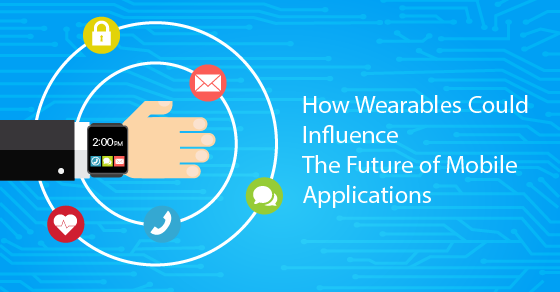"Transforming Your Business Using Machine Learning"
"Tips For Successful IoT Application Development"

Wearables seem to have opened up a section in the digitalization which was completely notional. Not only this, the technology has opened a new world of possibilities and now it has come to a realization where wearable technology is more advanced than hand-held technology. The implications and benefits of wearable technology are vast as it is designed to mostly work along with your smartphone and serve as a secondary display for your handset.
The hype and demand of wearables across different industries are also increasing the need for custom mobile applications at a very fast pace. These smart gadgets are forcing a lot of enhancements and revise in the development of next-generation mobile applications. Let’s have a look at how wearables influence on mobile applications.
The applications being designed for wearables would be concise and tabs would be functionally assembled with highly precise and appropriate features, for easy access by users.
The mobile applications for wearables would be smaller in size to load swiftly and respond to individual commands instantly to make users more inclined to use the gadgets.
The next generation mobile applications for smart gadgets need to have quick computational skills with the real-time inputs and requirement of on-the-go outputs through sophisticated algorithms.
As the users like personalization, the application also focuses to engage the users with the app the way they want, such as single word notifications, voice memos as well as touch gestures.
The real-time usage of wearable devices demand mobile applications to ensure an extended battery life for a stretched period of time.
The mobile applications for wearables would need fast and flawless data transmission between smart devices centering their wearable strategy on WiFi and Bluetooth.
The mobile applications for smart gadgets would also need enhanced user interaction features, such as tapping, face and thumb recognition or responding to voice commands.
The mobile applications for smart gadgets would need integration with biometrics and semantics-based software to interpret feelings, track progress and detect biopotential.
The mobile applications for wearables would need real-time modernize to users and concerned person (e.g. doctors) about the present state of the users.
The mobile applications for smart gadgets would rely on artificial intelligence algorithms using big data technologies to predict user behavior and make alterations in execution.
The next generation mobile applications for wearables would rely on augmented reality techniques to enhance the user senses of gestures hearing, seeing, feeling and smelling.
Conclusion
To conclude, the demand for wearable devices will steer to the development of more sophisticated and advanced mobile applications. The next generation mobile applications for smart gadgets will blur the interface between users and the hardware gadgets. And every mobile application for smart gadgets will need a unique set of functionalities depending on the industry and the use of the wearable.